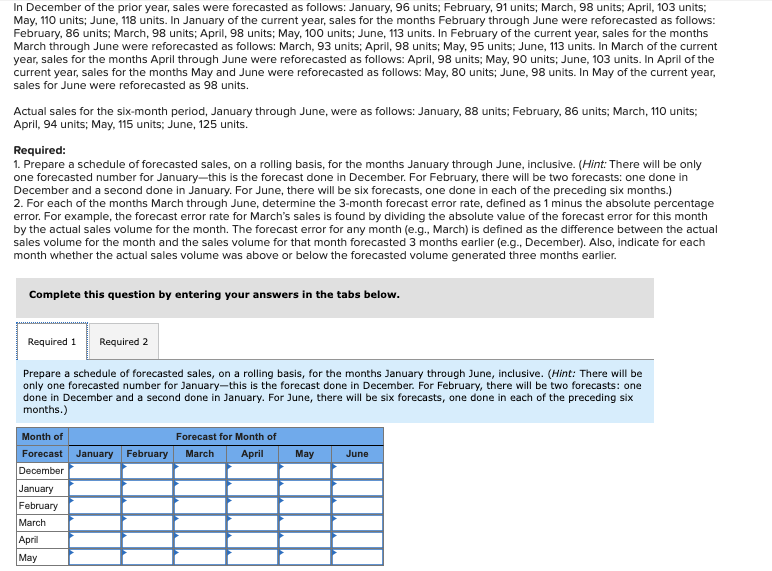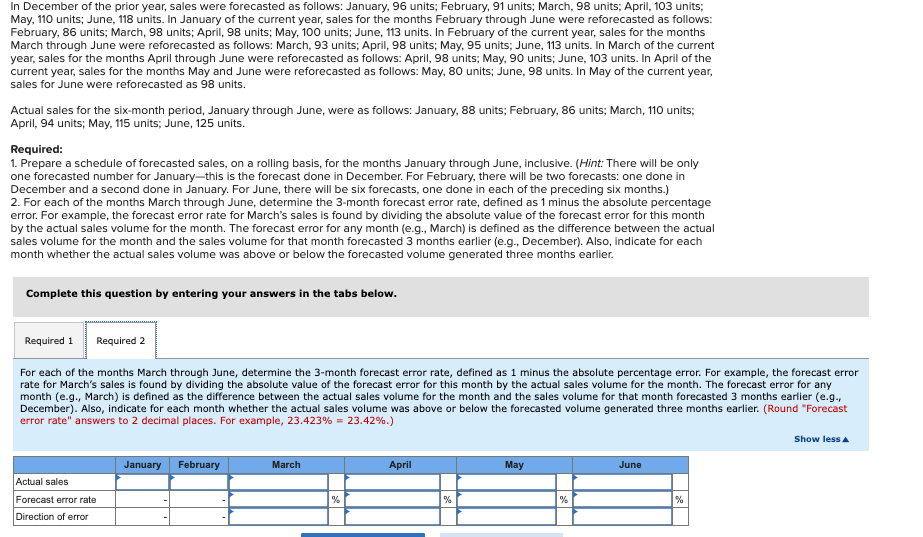Answered step by step
Verified Expert Solution
Question
1 Approved Answer
In December of the prior year, sales were forecasted as follows: January, 96 units; February, 91 units; March, 98 units; April, 103 units; May,


In December of the prior year, sales were forecasted as follows: January, 96 units; February, 91 units; March, 98 units; April, 103 units; May, 110 units; June, 118 units. In January of the current year, sales for the months February through June were reforecasted as follows: February, 86 units; March, 98 units; April, 98 units; May, 100 units; June, 113 units. In February of the current year, sales for the months March through June were reforecasted as follows: March, 93 units; April, 98 units; May, 95 units; June, 113 units. In March of the current year, sales for the months April through June were reforecasted as follows: April, 98 units; May, 90 units; June, 103 units. In April of the current year, sales for the months May and June were reforecasted as follows: May, 80 units; June, 98 units. In May of the current year, sales for June were reforecasted as 98 units. Actual sales for the six-month period, January through June, were as follows: January, 88 units; February, 86 units; March, 110 units; April, 94 units; May, 115 units; June, 125 units. Required: 1. Prepare a schedule of forecasted sales, on a rolling basis, for the months January through June, inclusive. (Hint: There will be only one forecasted number for January-this is the forecast done in December. For February, there will be two forecasts: one done in December and a second done in January. For June, there will be six forecasts, one done in each of the preceding six months.) 2. For each of the months March through June, determine the 3-month forecast error rate, defined as 1 minus the absolute percentage error. For example, the forecast error rate for March's sales is found by dividing the absolute value of the forecast error for this month by the actual sales volume for the month. The forecast error for any month (e.g., March) is defined as the difference between the actual sales volume for the month and the sales volume for that month forecasted 3 months earlier (e.g., December). Also, indicate for each month whether the actual sales volume was above or below the forecasted volume generated three months earlier. Complete this question by entering your answers in the tabs below. Required 1 Required 2 Prepare a schedule of forecasted sales, on a rolling basis, for the months January through June, inclusive. (Hint: There will be only one forecasted number for January-this is the forecast done in December. For February, there will be two forecasts: one done in December and a second done in January. For June, there will be six forecasts, one done in each of the preceding six months.) Month of Forecast for Month of April May June Forecast January February March December January February March April May In December of the prior year, sales were forecasted as follows: January, 96 units; February, 91 units; March, 98 units; April, 103 units; May, 110 units; June, 118 units. In January of the current year, sales for the months February through June were reforecasted as follows: February, 86 units; March, 98 units; April, 98 units; May, 100 units; June, 113 units. In February of the current year, sales for the months March through June were reforecasted as follows: March, 93 units; April, 98 units; May, 95 units; June, 113 units. In March of the current year, sales for the months April through June were reforecasted as follows: April, 98 units; May, 90 units; June, 103 units. In April of the current year, sales for the months May and June were reforecasted as follows: May, 80 units; June, 98 units. In May of the current year, sales for June were reforecasted as 98 units. Actual sales for the six-month period, January through June, were as follows: January, 88 units; February, 86 units; March, 110 units; April, 94 units; May, 115 units; June, 125 units. Required: 1. Prepare a schedule of forecasted sales, on a rolling basis, for the months January through June, inclusive. (Hint: There will be only one forecasted number for January-this is the forecast done in December. For February, there will be two forecasts: one done in December and a second done in January. For June, there will be six forecasts, one done in each of the preceding six months.) 2. For each of the months March through June, determine the 3-month forecast error rate, defined as 1 minus the absolute percentage error. For example, the forecast error rate for March's sales is found by dividing the absolute value of the forecast error for this month by the actual sales volume for the month. The forecast error for any month (e.g., March) is defined as the difference between the actual sales volume for the month and the sales volume for that month forecasted 3 months earlier (e.g., December). Also, indicate for each month whether the actual sales volume was above or below the forecasted volume generated three months earlier. Complete this question by entering your answers in the tabs below. Required 1 Required 2 For each of the months March through June, determine the 3-month forecast error rate, defined as 1 minus the absolute percentage error. For example, the forecast error rate for March's sales is found by dividing the absolute value of the forecast error for this month by the actual sales volume for the month. The forecast error for any month (e.g., March) is defined as the difference between the actual sales volume for the month and the sales volume for that month forecasted 3 months earlier (e.g., December). Also, indicate for each month whether the actual sales volume was above or below the forecasted volume generated three months earlier. (Round "Forecast error rate" answers to 2 decimal places. For example, 23.423% = 23.42%.) Actual sales Forecast error rate Direction of error January February March % April % May % June % Show less
Step by Step Solution
There are 3 Steps involved in it
Step: 1

Get Instant Access to Expert-Tailored Solutions
See step-by-step solutions with expert insights and AI powered tools for academic success
Step: 2

Step: 3

Ace Your Homework with AI
Get the answers you need in no time with our AI-driven, step-by-step assistance
Get Started


